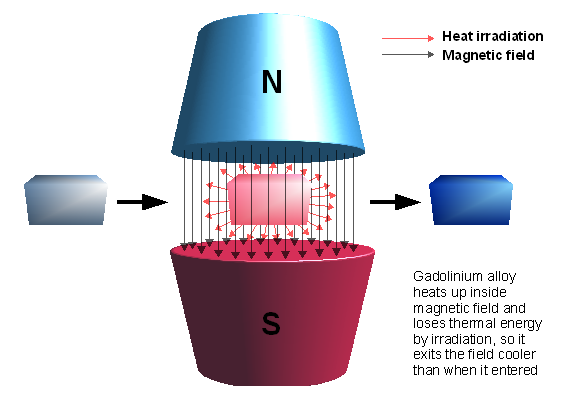A collaborative team of researchers from TU Braunschweig, the Helmholtz-Zentrum Dresden-Rossendorf (HZDR), and the Jülich Centre for Neutron Science (JCNS) has revealed remarkable magnetocaloric properties in the desert mineral atacamite—paving the way for a new class of energy-efficient cooling technologies. Published in Physical Review Letters (DOI: 10.1103/PhysRevLett.134.216701), the study demonstrates that atacamite’s magnetocaloric effect at cryogenic temperatures far exceeds expectations, offering fresh insights into the physics of magnetically frustrated materials and their potential applications.
What Is Magnetocaloric Cooling?
Traditional refrigeration relies on the compression and expansion of gaseous coolants—processes that demand high energy input and often use environmentally harmful substances. Magnetocaloric cooling, by contrast, exploits the temperature change that occurs when certain materials are exposed to changing magnetic fields. When a magnetocaloric substance is magnetized, its magnetic moments align, reducing magnetic entropy and releasing heat; when the field is removed, the moments become disordered, absorbing heat and producing a cooling effect.
Atacamite: A Desert Mineral with Hidden Potential
Atacamite, an emerald-green copper chloride hydroxide initially discovered in Chile’s Atacama Desert, is best known to collectors for its vibrant hues and crystalline forms. Its true scientific value, however, lies in the arrangement of copper ions within its lattice. Each copper ion carries an unpaired electron—effectively a tiny magnet—and in atacamite these ions form one-dimensional “sawtooth” chains of linked triangles.
Magnetic Frustration in Sawtooth Chains
Ordinarily, neighboring magnetic moments prefer to align antiparallel, minimizing their combined energy. But in a triangular geometry, perfect antiparallel alignment is geometrically impossible—a phenomenon known as magnetic frustration. As Dr. Leonie Heinze (JCNS) explains, “The triangular linkage of copper ions in atacamite prevents a simple alternating up-down spin configuration. This frustration delays the establishment of long-range magnetic order until temperatures drop below 9 K.”
Stranger Than Expected: Atacamite’s Cryogenic Cooling
To probe atacamite’s magnetocaloric response, the team subjected samples to pulsed magnetic fields of up to 60 tesla at HZDR’s High Magnetic Field Laboratory (HLD). Remarkably, the mineral’s temperature plunged to nearly half its starting point—an unusually large drop for a naturally occurring compound.
Unraveling the Cooling Mechanism
Further experiments, including magnetic resonance spectroscopy and neutron scattering at partner EMFL facilities, revealed the root of atacamite’s extreme response. While the applied field aligns spins on the sawtooth tips—reducing frustration—it simultaneously severs weak interchain couplings that sustain long-range order. The abrupt loss of magnetic order sharply increases magnetic entropy. To restore thermodynamic equilibrium, the material’s lattice cools dramatically.
Dr. Tommy Kotte (HZDR) summarizes, “Atacamite exhibits two competing effects under a magnetic field: frustration reduction along the chains, and decoupling between chains. The latter destroys the mineral’s static order, triggering an unusually strong magnetocaloric cooling.”
Implications for Next-Generation Refrigeration
Although atacamite itself—stable only at cryogenic temperatures—may not form the basis of household refrigerators, the study uncovers a general mechanism for enhancing magnetocaloric performance in frustrated magnetic materials. By engineering synthetic analogues or exploring related minerals, scientists could design solid-state coolers that operate without greenhouse-gases and at high efficiency.
Potential Applications
- Cryogenic Systems: Replacement of conventional helium-based refrigerators used in quantum computing, medical imaging (MRI), and fundamental physics research.
- Industrial Gas Liquefaction: Energy-efficient liquefaction of oxygen, nitrogen, or hydrogen for chemical and aerospace industries.
- Domestic and Commercial Cooling: Long-term goal of room-temperature magnetocaloric coolers for environmentally sustainable air-conditioning and refrigeration.
Toward a Targeted Search for Novel Materials
Building on this breakthrough, researchers plan to screen a broad class of magnetically frustrated minerals and designer crystals. Computational materials science—combining density functional theory and machine-learning techniques—will guide the synthesis of compounds whose magnetic lattices mimic or improve upon atacamite’s sawtooth architecture.
Next Steps in the Laboratory
- Low-Temperature Thermodynamic Mapping: Detailed measurements of entropy changes across a variety of magnetic field strengths and temperatures.
- Chemical Substitution Studies: Introducing different metal ions (e.g., nickel, manganese) into the atacamite framework to tune magnetic interactions.
- Thin-Film Fabrication: Growing epitaxial films of frustrated magnets to assess scalability and integration into practical devices.
A New Chapter in Magnetocaloric Research
This study highlights the untapped potential of naturally occurring minerals—long valued for their aesthetic qualities—as repositories of exotic physics. Atacamite’s dramatic magnetocaloric response underscores the importance of exploring magnetic frustration as a design principle for next-generation cooling materials.
Dr. Tommy Kotte reflects, “We don’t expect refrigerators made of desert rocks, but the fundamental principle we uncovered—entropy change driven by field-induced disorder in frustrated magnets—opens exciting pathways. Our work invites the community to mine the vast landscape of frustrated materials for compounds with even larger cooling effects at accessible temperatures.”
Funding and Acknowledgments
This research was supported by the European Magnetic Field Laboratory (EMFL), the German Research Foundation (DFG), and grants from the TU Braunschweig Excellence Initiative. The authors thank the HLD team for technical support with high-field experiments, and JCNS for neutron beamtime allocations.
READ MORE: Engineers Pioneer Miniaturized Wireless Implant to Relieve Chronic Pain
